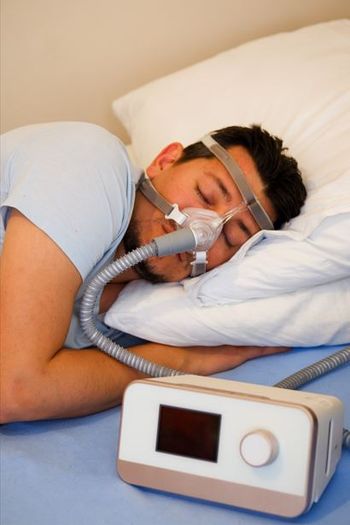
Neurological Disorders Afflict Millions
BETHESDA, Md. -- Nearly three million Americans are living after a stroke, reported government researchers. There are more than two million patients with epilepsy, and migraine affects more than 35 million lives.
BETHESDA, Md., Jan. 30 -- Government investigators have tried to pull together a rough estimate of the scope of neurological diseases in America.
They made estimates of the incidence or prevalence of a dozen diseases or conditions seen commonly by neurologists, and they came up with millions of patients, even by the relatively narrow and arbitrary criteria the researchers selected.
For instance, nearly three million Americans are living after a stroke, more than two million have epilepsy, and more than 35 million live with migraine, reported Deborah Hirtz, M.D., of the National Institutes of Neurological Disorders and Stroke here, and colleagues at the CDC in Atlanta.
The investigators used the best available data on the incidence of some disorders and the prevalence of others, and extrapolated from other sources when reliable data about disease burden were not available, they wrote in the Jan. 30 issue of Neurology.
But there is a paucity of data on some diseases, making it hard to estimate the true magnitude of the problem, the authors asserted.
"For many neurologic disorders, we need better studies of incidence and prevalence to improve the accuracy of estimates, to enable more confident generalizations to broader populations, and to assess trends," they wrote. "Beyond incidence and prevalence, additional research is needed to allow a more complete estimate of burden of illness that includes potential years of life lost, productive years lost to disability, impact on caregivers, and economic costs."
Some of 12 disorders have a typical onset early in life (such as autism), others of which may occur at any time of life, such as brain or spinal cord injury, and others that normally occur later in life, such as Alzheimer's disease and Parkinson's disease.
In some cases when reliable US or Canadian studies were not available, the investigators had to rely on European data for the estimates.
The disorders studied were:
- Autism spectrum disorders
- Cerebral palsy
- Tourette's syndrome
- Migraine
- Epilepsy
- Multiple sclerosis
- Traumatic brain injury
- Spinal cord injury
- Amyotrophic lateral scleorsis
- Stroke
- Alzheimer's disease
- Parkinson's disease
"We selected a limited number of disorders of the CNS that neurologists are likely to diagnose and treat and that are generally presumed to have a high burden of illness," the authors wrote.
"We did not address other frequent and burdensome conditions, such as chronic pain, mental retardation, peripheral neuropathies, or sleep disorders, some of which lack well-established diagnostic criteria or are treated primarily by non-neurologists."
They found that the estimated prevalence for autism spectrum disorders, including autism, Asperger's syndrome, and related conditions, was 500,000 yielding a prevalence rate of 5.8 per 1,000 children, a rate similar to that found in other recent studies. The male-to-female rate ratio for autism spectrum disorders was 4.2 (4.2:1). Again, this ratio was similar to that reported in other studies.
Data from eight European and one high quality U.S. study suggested a mean prevalence for cerebral palsy of 207,000, for a rate of 2.4 per 1,000 in those younger than 21.
For the estimated 301,000 thousand children living with Tourette's syndrome, however, the data were insufficient to yield a firm estimate of the rate. The best prevalence rate "guestimate" for Tourette's syndrome was 3.5, the authors said.
The one-year estimated prevalence in the general population of migraine was 121.7 per 1,000, with an overall estimated prevalence of 35,461,000, and a male-to-female rate ratio of 0.4.
Epilepsy was estimated to have a prevalence of 2,098,000 Americans (7.1 per 1,000), occurring equally in men and women.
The prevalence of MS was estimated to be 266,000 (0.9/1,000) with more women than men being affected (male-to-female rate ratio 0.5).
Among patients 65 years and older, the prevalence of Alzheimer's was 2,459,000, or 67 per 1,000. The disease was more prevalent among women, with a male-to-female rate-ratio of 0.5
The prevalence of Parkinson's disease was 349,000 (9.5/1,000) among Americans 65 and older. More men than women were affected, with a male-to-female rate-ratio of 1.8.
For those diseases best described by annual incidence, the irate of stroke was 183 per 100,000 (541,000 new cases annually), major traumatic brain injury was estimated to occur in 298,000 people (101 per 100,000), spinal cord injury was estimated in 13,000 (4.5 per 100,000), and ALS was newly diagnosed in about 5,000 (1.6/100,000) per year.
"Although essential to any consideration of disease burden, neither incidence nor prevalence captures the full impact of disorders in human and economic dimensions," the authors wrote. "These broader consequences are encompassed by the term burden of illness. Estimates of human burden must consider not only the frequency of a disease but also the years of life lost and the duration, character, and degree of disability and suffering as well as the impact on family and society."
In an accompanying editorial, Steven M. Alpert, Ph.D., M.S.P.H., of the University of Pittsburgh, questioned the accuracy of the findings, noting that the methods the authors had to rely on less than ideal data for their prevalence estimates.
"These are reasonable strategies but remind us that projections of disease prevalence are almost always based on an aggregation of studies that use different approaches to sampling and sometimes even different diagnostic criteria," he wrote.
He also noted that the authors were not able to include estimates of changes in the severity of disease burden in their estimates.
Newsletter
Enhance your clinical practice with the Patient Care newsletter, offering the latest evidence-based guidelines, diagnostic insights, and treatment strategies for primary care physicians.
































































































































































































































































































































